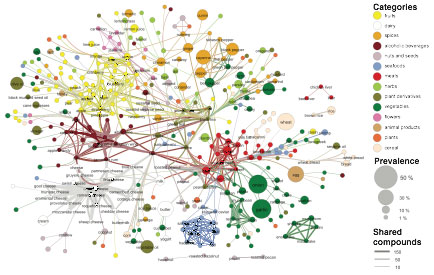My Most Flavorful Explanation. Would You Like Blue Cheese With It?
It would take about 100 years to try the 100,000 recipes carried on Epicurious, the largest recipe portal in the US.What fascinates me about this number is not how huge it is, but rather how tiny. Indeed, a typical dish has about eight ingredients. Thus the roughly 300 ingredients used in cooking today allow for about 1,000,000,000,000,000distinct dishes. Add to this your choice of deep freezing, frying, smashing, centrifuging, or blasting your ingredients, and you start to see why cooking is a growth industry. It currently uses only a negligible fraction of its resources—less than one in a trillion dishes that culinary combinatorics permits.
Don't you like green eggs and ham? Or why leave this vast terra incognita unexplored? Do we simply lack the time to taste our way through this boundless bounty, or is it because most combinations are repugnant anyway? Could there be some rules that explain liking some ingredient combinations and avoiding others? The answer appears to be yes, which leads me to my most flavorful explanation to date.
As we search for evidence to support (or refute) any 'laws' that may govern our culinary experiences, we must bear in mind that food sensation is affected by many factors, from color to texture, from temperature to even sound. Yet palatability is largely determined by flavor, representing a group of sensations including odors, tastes, freshness and pungency. This is mainly chemistry, however. Odors are molecules that bind olfactory receptors, tastes are chemicals that stimulate taste buds, freshness or pungency are driven by chemical irritants in our mouth and throat. Therefore, if we want to understand why we prize some ingredient combinations and loathe others, we have to look at the chemical profile of our recipes.
But how can chemistry tell us which ingredients taste well together? Well, we can formulate two orthogonal hypotheses. First, we may like some ingredients together because their chemistry (and henceforth their flavor) is complementary—what one lacks, is provided by the other. The alternative is its polar opposite: taste is like color matching in fashion—we prefer to pair ingredients that already share some flavor compounds, bringing them in chemical harmony with each other. Before you go on reading, I urge you to stop for a second and ponder which of these would you find more plausible.
To this day, it is the first one that makes more sense to me: I put salt in my omelet not because the chemical bouquet of the egg shares the salt's only chemical, NaCl, but precisely because it is missing it. Yet, lately chefs and molecular gastronomers are betting on the second hypothesis, and they even gave it a name, calling it the food pairing principle. Its consequences are already on your table: some contemporary restaurants serve white chocolate with caviar, as they share trimethylamine and other flavor compounds, or chocolate and blue cheese that share at least 73 flavor compounds. Yet, evidence for food pairing is at best anecdotal, making a scientist like myself ask: is this more than a myth?
So whom should I trust, my intuition or the molecular gastronomers? And how to really test if two ingredients indeed go well together? Our first instinct was to taste under controlled conditions all ingredient pairs. Yet 300 ingredients offer about 44,850 pairs to sample, forcing us to search for smarter ways to settle the question. Having spent the last decade trying to understand the laws governing networks, from the social network to the intricate web of genes governing our cells, we decided to rely on network science. We therefore compiled the flavor components of over 300 ingredients and organized them into a network, linking two ingredients if they share flavor compounds. We then used the collective intelligence accumulated in the existing body of recipes to test what goes with what. If two common ingredients are almost never combined, like garlic and vanilla, there must be a reason for it—those who tried it, may have found it either uninspired or outright repulsive. If, however, two ingredients are more often together than we would expect based on their individual popularity, we took that as a sign that they must taste well together. Tomato and garlic are in this category, combined in 12 percent of all recipes.
The truth is rather Dr. Seussian at the end: we may like some combinations here, but not there. That is, North American and Western European cuisine show a strong tendency to combine ingredients that share chemicals. Hence, color matching dominates much of the western cuisine. If you are here, serve parmesan with papaya and strawberry with beer. Do not try this there, however: East Asian cuisine thrives through avoiding ingredients that share favor chemicals. So if you hail from Asia, yin yang is your guiding force: seeking harmony through pairing the polar opposites. Do you like soy sauce with honey? Try them and you may, I say.


















